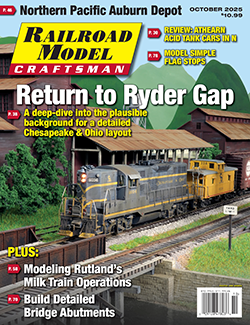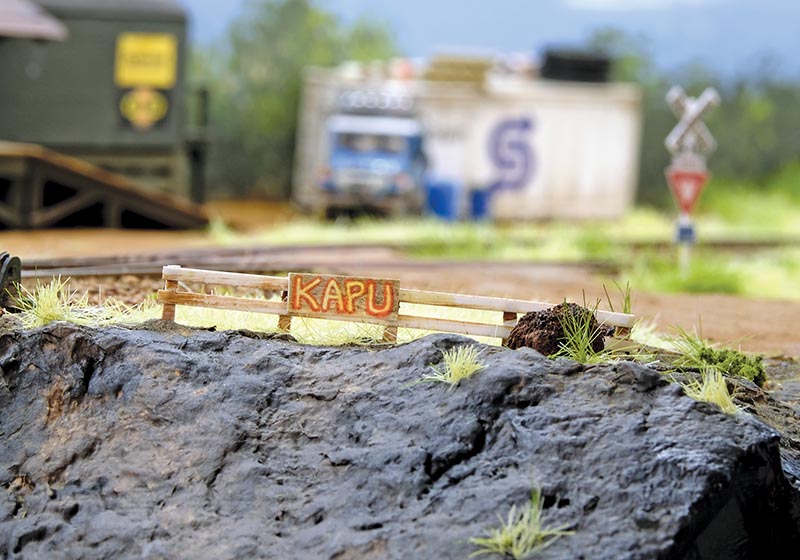 If your goal is to create a model railroad that emphasizes realism, you need to be a highly observant student of the real world around us. Throughout my years of modeling, I’ve found that realism comes from significantly reducing the amount of “clutter” on a model railroad and emphasizing subtle details that may not stand out but are crucial to creating a convincing scene.
If your goal is to create a model railroad that emphasizes realism, you need to be a highly observant student of the real world around us. Throughout my years of modeling, I’ve found that realism comes from significantly reducing the amount of “clutter” on a model railroad and emphasizing subtle details that may not stand out but are crucial to creating a convincing scene.
What do I mean?
Take a walk or drive along the nearby local railroad right-of-way from a safe public vantage point — do not trespass on railroad property. Be observant. You will first see a lot of open, empty spaces. Look closer. Do you spot any small electrical boxes located alongside the track? Is there a mound of ballast, or a pile of rusted tie plates half hidden in the weeds? What about small signposts printed with railroad-specific information?
Look a little farther away from the track now. Are there streets that dead-end at the tracks? What kind of barricade is in place to stop motorists from driving onto the track? Do you see any bright white-and-orange markers indicating buried fiber-optic lines in the ditches near the tracks? Are there subtle indications of an industry located near the tracks?
The exercise here is to actually notice the mundane, everyday, normal objects that are present along the right-of-way. It’s these subtle, subliminal details that, when included in our model railroads — regardless of the era — help elevate realism. Adding regional or “scene-specific” details can also provide a similar covert way to evoke a sense of place or location.
I model a “could have been” proto-freelance railroad concept on my HO scale Big Island Rail and Kawaihae Harbor Railroad. I use the premise that the actual Hilo-based, standard-gauge Hawaii Consolidated Railway was rebuilt and continued to prosper after the devastating April 1, 1946, tsunami slammed into the east coast of the Big Island. My shelf layout features a marine rail operation based closely on the real Port of Kawaihae, located on the western shores north of Kona.
Hawaii has a unique culture. I wanted to subtly bring that feeling to my model railroad, without the “in your face” stereotype of luaus and loud shirts.
Compared to the rainy eastside Hilo area, the Big Island’s west side is very dry and arid, with golden grasses sprouting up through ancient lava flows. I have incorporated this to give the impression of the Big Island’s South Kohala district.
I used signs and logos from Kawaihae Harbor industries, such as Young Brothers, a prominent shipping company that does inter-island shipments, to give a sense of place. Other subtle details that give a hint as to the layout’s Hawaiian roots include a small sign posted on a fence that says “Kapu,” Hawaiian for “forbidden, no trespassing.”
A very common safety item found at small boat marinas and large shipping ports alike is life rings. Nowadays, life rings are kept inside brightly colored housings attached to docks and walkway handrails. I used a photo of a life ring housing from the internet to make my own. Using dimensions found online, I scaled down the photo and mounted it on a styrene base then attached it to my barge ramp.
Another common feature at harbors and ports is fire suppression equipment. I built a simple fire hose cabinet using polystyrene shapes and sheet stock.
Navigable waterway channel markers are details that are rarely modeled but should be. These stationary markers, both on land and in water, indicate the sides of a waterway channel to help boats and ships avoid hazards. I built mine using spare parts, signs from the internet, and a flashing red warning light. Commonly found everywhere are bright orange-and-white buried fiber optic cable locator posts. I made mine from a polystyrene rod with one end dipped in Tamiya orange acrylic paint.
Including these subliminal, real-world, and location-specific details will significantly boost realism. While the examples shared here are specific to my layout based in Hawaii, you’ll be able to find examples that perfectly fit your railroad and era if you take the time to look around. If you’re modeling a Nevada short line, include an ad for one of the state’s many casinos. A layout set in eastern Massachusetts might feature a Boston Globe newspaper box. Or one in the South might have buildings with bulky “swamp coolers” hanging out of every window. These everyday details, while small, will go a long way toward bringing realism to your railroad.
—Joseph Kreiss



